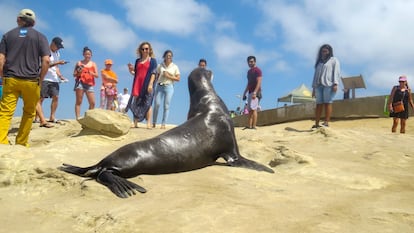The Battle of La Jolla: Tourists and sea lions fight over a California beach
The deaths of three sea lion pups and several viral videos of encounters with humans have revived a years-long struggle between environmentalists and residents in San Diego

The images swiftly went viral. A pair of sea lions come out of the sea and chase several people fleeing in terror from the beach in La Jolla, Southern California. For tourists, it is the peak of the summer season. For the sea animals, however, which usually give birth in April, it is the height of breeding season, which could explain their aggressive and territorial behavior. The clash between humans and sea lions is neither new nor unusual, but it has led to calls for action on the part of the San Diego city authorities.
“We want the beach to be exclusively for humans,” Bob Evans, the president of La Jolla Parks and Beaches, an organization that helps authorities preserve green areas, recently noted. “Every day that goes by, the risk is greater for people and wildlife. Every day that goes by we lose part of our beach,” he added in an interview with local television.
The organization is seeking action from authorities in San Diego to prevent sea lions and seals from entering La Jolla Cove, a tiny strip of sand flanked by cliffs. During the summer, tourists and visitors swim in the waters and sunbathe on the beach, which is less than 200 meters long.
Evans’ concern is that the viral images recorded a few days ago will lead authorities to favor wildlife and thus decree the closure of access to the beach for humans.
At the same time, the Sierra Club Foundation, an environmental organization, is also asking the city of San Diego to intervene in what they have termed “an emergency.” The organization claims that three sea lion pups, only a few weeks old, were found dead over the course of six days after the July 4 festivities. They have reason to suspect that these deaths were caused by or related to humans.
“One of the pups was found on a public beach partially buried in the sand with the pincers of a lobster placed on its head as if they were horns,” the organization said in a statement. In the message they made clear that “this level of mortality did not occur in areas that were closed to human passage.”

Robyn Davidoff, one of the leaders of the group, asked the authorities to seek the advice of sea lion experts to get an understanding of what can be expected of them at this time of the year, and thus avoid scenes such as those captured by cell phones. Davidoff indicates that the association is not seeking to close the area.
La Jolla Cove remains open and unrestricted to visitors, who can swim and do water sports. Sierra Club’s activism work, however, was instrumental in 2014 in getting the city to decree the closure of Casa Beach, where seals and sea lions give birth to their pups, between December 15 and May 15.
The closure orders were extended three years later to another fragment of the coast, the area from La Jolla Point to Boomer Beach. Environmentalists then succeeded in preventing human passage to a rocky area where sea lions and seals often give birth.
Evans and his organization fear that authorities may now extend the ban to the popular disputed cove. The authorities, for the moment, have not made any statement following the latest conflict. The last public stance by the City Council came two years ago, when they imposed a ban on access to the area from Boomer Beach to Punta La Jolla between May 31 and October 31, during the breeding season. This order will be in effect until 2030.
Shortly before the council adopted the 2022 measure, images like the ones circulating now had exploded on social media. Videos of tourists being terrorized by sea lions in La Jolla Cove were seen by more than nine million people on TikTok. The victim then was a woman who had gotten too close to a sleeping cub to take a photograph of it. The cub’s mother took it as a sign of danger and aggressively saw off the woman. The beach is covered with warnings about the aggressive behavior of these animals.
Davidoff and Carol Toye, another Sierra Club leader, pointed out to the local press earlier this month that people are prohibited from approaching the animals. “It’s not only unacceptable. It is also illegal. The Marine Mammal Protection Act protects sea lions from harassment. Being so close to them is dangerous for people,” they asserted.
Sign up for our weekly newsletter to get more English-language news coverage from EL PAÍS USA Edition
Tu suscripción se está usando en otro dispositivo
¿Quieres añadir otro usuario a tu suscripción?
Si continúas leyendo en este dispositivo, no se podrá leer en el otro.
FlechaTu suscripción se está usando en otro dispositivo y solo puedes acceder a EL PAÍS desde un dispositivo a la vez.
Si quieres compartir tu cuenta, cambia tu suscripción a la modalidad Premium, así podrás añadir otro usuario. Cada uno accederá con su propia cuenta de email, lo que os permitirá personalizar vuestra experiencia en EL PAÍS.
¿Tienes una suscripción de empresa? Accede aquí para contratar más cuentas.
En el caso de no saber quién está usando tu cuenta, te recomendamos cambiar tu contraseña aquí.
Si decides continuar compartiendo tu cuenta, este mensaje se mostrará en tu dispositivo y en el de la otra persona que está usando tu cuenta de forma indefinida, afectando a tu experiencia de lectura. Puedes consultar aquí los términos y condiciones de la suscripción digital.
More information
Archived In
Últimas noticias
Most viewed
- Sinaloa Cartel war is taking its toll on Los Chapitos
- Oona Chaplin: ‘I told James Cameron that I was living in a treehouse and starting a permaculture project with a friend’
- Reinhard Genzel, Nobel laureate in physics: ‘One-minute videos will never give you the truth’
- Why the price of coffee has skyrocketed: from Brazilian plantations to specialty coffee houses
- Silver prices are going crazy: This is what’s fueling the rally










































